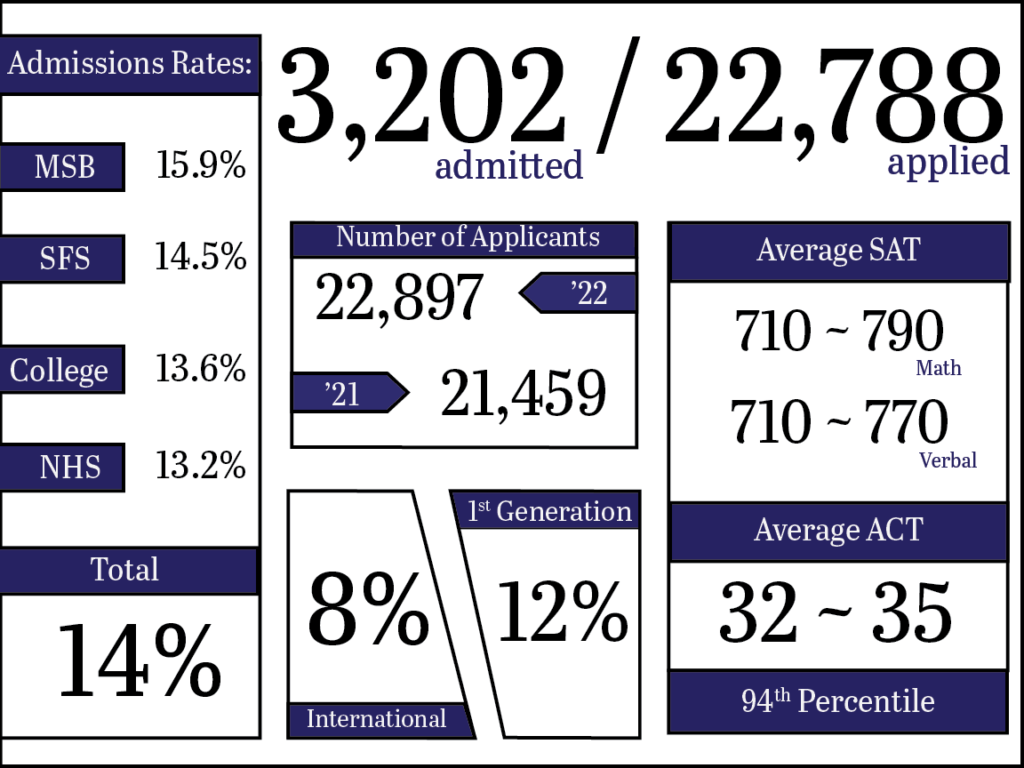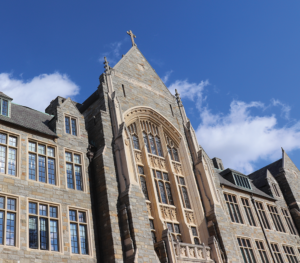Georgetown University’s undergraduate acceptance rate dropped to 14 percent this admissions season, the lowest in the university’s history, marking the third consecutive year of record-low acceptance rates for Georgetown.
A total of 3,202 applicants were admitted to the Class of 2023 from a pool of 22,788 in hopes of meeting an enrollment target of 1,600 first-year students, according to Dean of Undergraduate Admissions Charles Deacon (CAS ’64, GRD ’69).
“This is the lowest April 1 admit rate,” Deacon wrote in an email to The Hoya. “Although the pool was virtually unchanged from last year’s record number, we did offer 130 fewer acceptances because the yield (those saying yes) has increased and last year we enrolled 1621 with a goal of 1600.”

This year marks a slight decrease in the size of the applicant pool compared to last year’s record-breaking high of 22,897 applicants, which followed the previous record of 21,459 applicants for the Class of 2021.
The School of Nursing and Health Studies saw a 12 percent rise in applicants since last year’s admissions cycle, with a total of 1,682 applications compared to last year’s 1,500. This year, 222 students were admitted to the NHS with an acceptance rate of 13.2 percent, the lowest acceptance rate of the four undergraduate schools.
Outside of the NHS, each undergraduate school saw a decline in the size of its application pool since last year, resulting in a lower number of applicants overall compared to the Class of 2022.
The College received 13,704 applications with an acceptance rate of 13.6 percent; the School of Foreign Service accepted 14.5 percent of its 4,109 applicants; and the McDonough School of Business had a pool of 3,322 applications, accepting 15.9 percent.
Twenty-two percent of students admitted to Georgetown’s Class of 2023 are Asian-American, 12 percent are Latinx, 11 percent are black and 1 percent are Native American. Eight percent of admitted students are international.
First-generation students represent 12 percent of the class, up slightly from last year’s 11 percent. The admissions office cites programs like the Community Scholars Program and the Georgetown Scholars Program that provide support for first-generation and low-income Georgetown undergraduates as part of Georgetown’s initiative to admit a more socio-economically and racially diverse class of students, including first-generation college students.

The median family income of a student at Georgetown, as of 2017, was $229,100, with 74 percent of students coming from the top 20 percent, while 3.1 percent of students’ family incomes fall in the bottom 20 percent, according to a 2017 report by The New York Times.
Georgetown remains need-blind when reviewing applications and guarantees to meet demonstrated need for all accepted students, according to Deacon. The policy has been in place since the late 1970s.
Legacy students make up 8.7 percent of the admitted class of 2023, according to Deacon.
“Of the 3202 total admits, just 2.5% received a legacy tip since most legacy admits are competitive on their own merits,” Deacon wrote.
This admissions cycle comes amid a March 12 indictment by the Department of Justice in which a former Georgetown tennis coach was charged with accepting bribes from parents in exchange for their children’s admission to the university. The coach left the university in December 2017 after an internal investigation.
Student athletes are admitted to the university through a recruitment process spearheaded by university coaches, according to Deacon.
“Coaches recruit talented student athletes and have been allowed to support the admission of a limited number of these athletes,” Deacon wrote. “The role of admissions is to verify the academic talent of those recommended.”
Georgetown admitted students from all 50 states, the District of Columbia, Guam, Puerto Rico and the U.S. Virgin Islands. Admitted students to the Class of 2023 also came from 77 foreign countries, slightly lower than last year’s representation of 81 foreign countries.
This admissions cycle, the university received the highest number of applicants from California — 2,632 — followed by 2,527 applications from countries outside the United States and 2,177 applications from students in the state of New York.
New Jersey, Maryland, Virginia, Massachusetts, Florida, Texas and Pennsylvania completed the list of the top 10 regional sources of applicants.
Overall, admitted students ranked within the top six percent of their high school class. The median score range for the SAT was between 710 and 790 for the math section and between 710 and 770 for the verbal section. The median score range for the ACT was between 32 and 35.
Georgetown holds a no “score choice” policy, meaning students must submit their scores from all standardized tests they have taken rather than sending only their highest scores. Georgetown also differs from most universities by using its own application rather than allowing students to apply via the Common Application or Coalition Application.
Georgetown’s separate application limits its applicant pool to those who are seriously interested in the university, allowing most applicants to interview with an alumnus and personalizing Georgetown’s admissions process, according to Deacon.
“We have never deviated from the belief that a student centered admissions policy begins with the relationship established between the student and college through the application process,” Deacon wrote.
This article was updated on April 6 to clarify the age of the median income data.




















